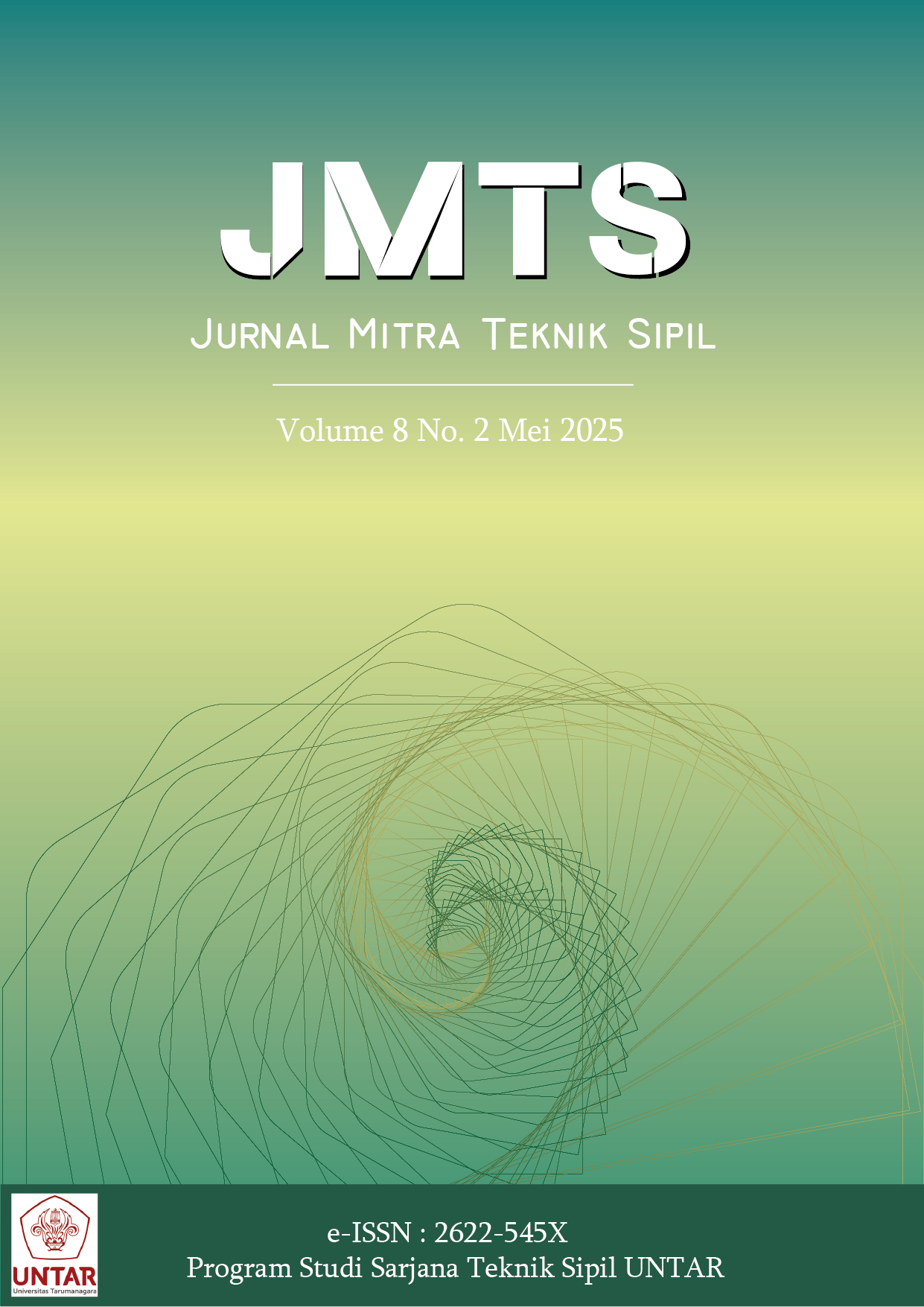PENGARUH PENGGUNAAN PALM OIL FUEL ASH SEBAGAI SUBSTITUSI SILICA FUME PADA REACTIVE POWDER CONCRETE
Main Article Content
Abstract
Concrete is an essential component in building and infrastructure construction, used for both structural and non-structural purposes. The innovation of using palm oil fuel ash (POFA) in reactive powder concrete (RPC) is expected to enhance the compressive and flexural strength of RPC as well as its workability. This research includes five types of RPC mixtures: 100% silica fume & 0% POFA, 75% silica fume & 25% POFA, 50% silica fume & 50% POFA, 25% silica fume & 75% POFA, and 0% silica fume & 100% POFA. The POFA used is pre-burned at 1000°C and sieved using a no.200 sieve. The tests conducted in this study include compressive strength tests, flexural strength tests, and slump tests. The results indicate that the use of POFA leads to a decrease in the compressive strength of RPC by 56.93% and flexural strength by 34.8%, while the workability increases with the higher amount of POFA in the RPC mixture.
Abstrak
Beton adalah komponen penting dalam konstruksi bangunan dan infrastruktur, digunakan baik untuk keperluan struktural maupun non-struktural. Inovasi penggunaan palm oil fuel ash (POFA) pada reactive powder concrete (RPC) diharapkan dapat meningkatkan kuat tekan dan kuat lentur pada RPC serta meningkatkan workabilitasnya. Pada penelitian ini terdapat 5 jenis campuran RPC yaitu 100% silica fume & 0% POFA, 75% silica fume & 25% POFA, 50% silica fume & 50% POFA, 25% silica fume & 75% POFA, dan 0% silica fume & 100% POFA. POFA yang akan digunakan dibakar terlebih dahulu pada suhu 1000°C dan disaring menggunakan saringan no.200. Pengujian yang dilakukan pada penelitian ini meliputi pengujian kuat tekan, pengujian kuat lentur, dan slump test. Hasil pengujian yang sudah dilakukan menunjukkan bahwa penggunaan POFA mengakibatkan penurunan kekuatan tekan RPC sebesar 56,93% dan lentur RPC sebesar 34,8%, sedangkan pada workabilitas terjadi peningkatan seiring bertambahnya POFA yang digunakan dalam campuran RPC.
Article Details

This work is licensed under a Creative Commons Attribution-NonCommercial-ShareAlike 4.0 International License.
This work is licensed under Jurnal Mitra Teknik Sipil (JMTS) Creative Commons Attribution-ShareAlike 4.0 International License.References
Alkhaly, Y. R. (2013). Reactive powder concrete dengan sumber silika dari limbah bahan organik. Teras Jurnal: Jurnal Teknik Sipil, 3(2), 157-166. https://doi.org/10.29103/tj.v3i2.41
Amran, M., Murali, G., Fediuk, R., Vatin, N., & Vasilev, Y. (2021). Palm oil fuel ash-based eco-efficient concrete: A critical review of the short-term properties. Materials, 14(2), 332. https://doi.org/10.3390/ma14020332
Kushartomo, W., & Supiono, C. W. (2014). Pengaruh copper slag terhadap sifat mekanis reactive powder concrete. Jurnal Kajian Teknologi, 10(3), 175-182.
Kushartomo, W., & Tory, J. (2024). Analisis penggunaan poliamida pada RPC untuk meningkatkan ketahan terhadap temperatur. JMTS: Jurnal Mitra Teknik Sipil, 7(2), 643-650. https://doi.org/10.24912/jmts.v7i2.28036
Kushartomo, W., Wiyanto, H., & Christianto, D. (2021). Effect of cement–water ratio on the mechanical properties of reactive powder concrete with marble powder as constituent materials. Proceedings of the Second International Conference of Construction, Infrastructure, and Materials: ICCIM 2021, Indonesia, 216, 177-185. https://doi.org/10.1007/978-981-16-7949-0_16
Putri, W. R., Utama, P. S., & Olivia, M. (2021). Kuat tekan beton POFA (palm oil fuel ash) dengan bahan tambah silica fume. Jom FTEKNIK, 8(1).
Šoukal, F., Bocian, L., Novotný, R., Dlabajová, L., Šuleková, N., Hajzler, J., Koutný, O., & Drdlová, M. (2023). the effects of silica fume and superplasticizer type on the properties and microstructure of reactive powder concrete. Materials, 16(20), 6670. https://doi.org/10.3390/ma16206670



